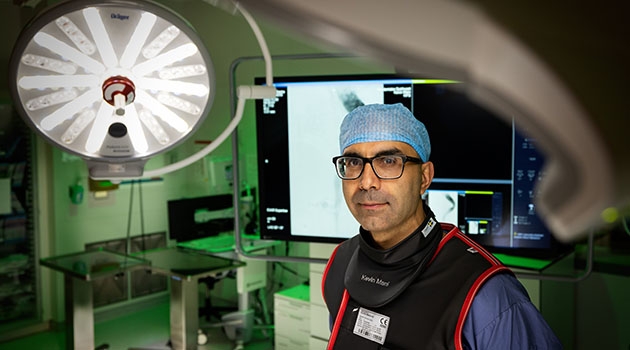New methods in vascular surgery save lives
In recent years, a huge development has taken place with new surgical techniques in aortic surgery. Today, medical conditions in most of the aorta can be treated with less invasive surgical methods, often with a 50% reduction in mortality and faster recovery for the person affected.
An aortic aneurysm is a silent disease that does not show any pre-symptoms. If the hernia in the artery ruptures, major internal bleeding ensues, which is life-threatening. The disease is one of the main causes of death in older people but can also affect younger people.
Kevin Mani, chief physician and adjunct professor of vascular surgery, has further developed surgical techniques in aortic surgery with his research group, such as laser technology and minimally invasive surgery. It is a method that involves entering the vascular system via an artery in the groin to strengthen the vessels in the aorta. There is a big difference to classic open surgery through the abdomen and chest where the vessels also need to be turned off.
of vascular surgery. Photo: Mikael Wallerstedt
“These days we can treat very advanced diseases,” says Kevin Mani. The most dangerous operation is to operate on the vessels closest to the heart or the brain at the aortic arch and we can now do this using minimally invasive methods, via small incisions in the groin. This development has taken place over the past five years. Before, operations on the aorta were too dangerous for patients aged 75 and older. Now one in four patients over the age of 80 can live for many more years.
“As a surgeon, it can be worrying to operate on a young patient with a 20 per cent risk of having really serious life-threatening complications. Today, we have achieved the goal of reducing the risk of surgeries to significantly lower levels. It is a relief both for the patient, relatives and for us surgeons – and a huge development in itself.
Personalised treatment
The Centre of Excellence in aortic disease is run by Uppsala University and Uppsala University Hospital where patients are offered individualised treatment through multidisciplinary collaboration.
“We also have ongoing international registry work at the centre,” Kevin Mani continues. It is a collaboration between 13 countries that analyse the data and evaluate the results of all operations using new techniques. The knowledge has a significant value – we are getting better at predicting which patients may benefit from a procedure, a bit like having access to a crystal ball before surgery.
an aorta at the imaging machine. Photo Cecilia Yates
The vascular surgery research group consists of a large network of both clinical and preclinical researchers. Among other things, there is a global collaboration programme, Uppsala Aortic Fellowship, where doctors from Asia, Europe, New Zealand and the USA have received training on the surgical methods employed at Uppsala and contributed to various research projects.
“The Aortic fellowship programme is very enriching and dynamic for our team,” says Kevin Mani. We train young researchers clinically and in how to conduct research and they contribute with their experiences from different parts of the world.
“We also have several exciting projects underway together with Dick Wågsäter, professor at the Department of Medical Cell Biology. The goal is to find a medical treatment and a drug that can stop the growth of an aortic aneurysm and prevent it from rupturing. Patients would then not have to be subjected to surgery in the future.”
Rewarding patient meetings
There is a hope that less invasive ways of treating patients will soon be developed. One challenge is to have patient-specific implants in an emergency. A navigation system independent of X-rays is also needed to protect patients and healthcare professionals from harmful X-ray radiation.
“I think we can have it available within five years,” says Kevin Mani. The most inspiring part of my job as a clinically active researcher is meeting patients, and developing new and more effective treatment techniques to help them. It is a privilege to meet and try to help people in such serious situations both in the clinic and in research.
“The research group meetings are also important. Both the surgery and research that we work with are a team effort. We are consistent in our efforts to try to solve problems. And it is extremely rewarding to see how younger colleagues develop and become independent clinicians and researchers,” concludes Kevin Mani.
Cecilia Yates
Facts about aortic aneurysms
An aortic aneurysm causes about 200,000 deaths worldwide annually.
Diseases of the aorta affect approximately 3-5% of the elderly population over 65 years of age. It is one of the top ten causes of death in older people. The disease can also affect younger people and is four times as common in men as in women.
The cause of the disease is not fully understood, but in some cases, the cause is a hereditary predisposition in combination with other risk factors. Studies have shown that smoking is of great significance.
For about 10 years now, all 65-year-old men in Sweden have been offered screening for aortic aneurysms. Thousands of hernia patients are found during the ultrasound examination and are then followed up for preventive purposes.
Find out more
The Uppsala Aortic Centre (UAC)
Research track Cardiovascular diseases
Research group: Immune cell activation and vascular remodellilng in aortic aneurysm
Publication: Gunnarsson K, Wanhainen A, Bjorck M, Djavani-Gidlund K, Mani K. “Nationwide Study of Ruptured Abdominal Aortic Aneurysms During Twenty Years (1994-2013)”. Annals of surgery. 2019, DOI: 10.1097/SLA.0000000000003555

